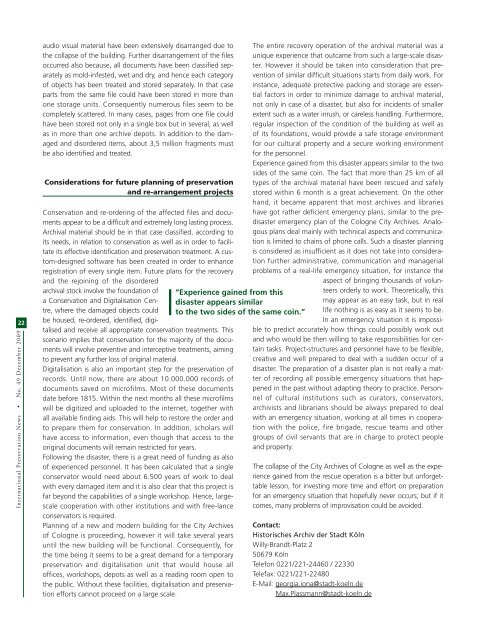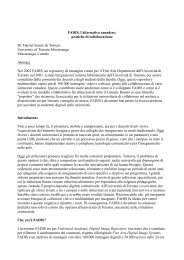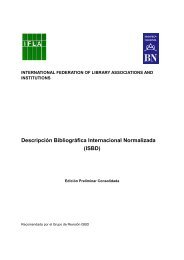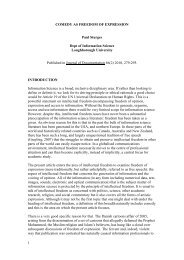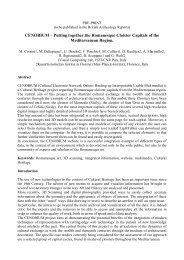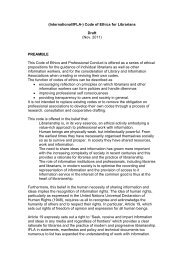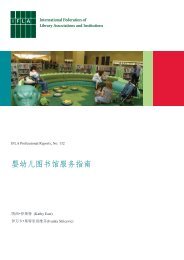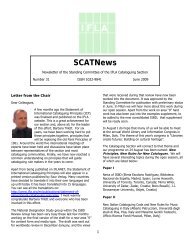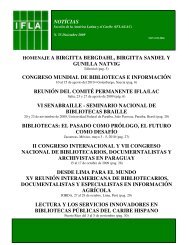No 49 - IFLA
No 49 - IFLA
No 49 - IFLA
You also want an ePaper? Increase the reach of your titles
YUMPU automatically turns print PDFs into web optimized ePapers that Google loves.
22<br />
International Preservation News <strong>No</strong>. <strong>49</strong> December 2009<br />
audio visual material have been extensively disarranged due to<br />
the collapse of the building. Further disarrangement of the files<br />
occurred also because, all documents have been classified separately<br />
as mold-infested, wet and dry, and hence each category<br />
of objects has been treated and stored separately. In that case<br />
parts from the same file could have been stored in more than<br />
one storage units. Consequently numerous files seem to be<br />
completely scattered. In many cases, pages from one file could<br />
have been stored not only in a single box but in several, as well<br />
as in more than one archive depots. In addition to the damaged<br />
and disordered items, about 3,5 million fragments must<br />
be also identified and treated.<br />
Considerations for future planning of preservation<br />
and re-arrangement projects<br />
Conservation and re-ordering of the affected files and documents<br />
appear to be a difficult and extremely long lasting process.<br />
Archival material should be in that case classified, according to<br />
its needs, in relation to conservation as well as in order to facilitate<br />
its effective identification and preservation treatment. A custom-designed<br />
software has been created in order to enhance<br />
registration of every single item. Future plans for the recovery<br />
and the rejoining of the disordered<br />
archival stock involve the foundation of<br />
a Conservation and Digitalisation Centre,<br />
where the damaged objects could<br />
be housed, re-ordered, identified, digitalised<br />
and receive all appropriate conservation treatments. This<br />
scenario implies that conservation for the majority of the documents<br />
will involve preventive and interceptive treatments, aiming<br />
to prevent any further loss of original material.<br />
Digitalisation is also an important step for the preservation of<br />
records. Until now, there are about 10.000.000 records of<br />
documents saved on microfilms. Most of these documents<br />
date before 1815. Within the next months all these microfilms<br />
will be digitized and uploaded to the internet, together with<br />
all available finding aids. This will help to restore the order and<br />
to prepare them for conservation. In addition, scholars will<br />
have access to information, even though that access to the<br />
original documents will remain restricted for years.<br />
Following the disaster, there is a great need of funding as also<br />
of experienced personnel. It has been calculated that a single<br />
conservator would need about 6.500 years of work to deal<br />
with every damaged item and it is also clear that this project is<br />
far beyond the capabilities of a single workshop. Hence, largescale<br />
cooperation with other institutions and with free-lance<br />
conservators is required.<br />
Planning of a new and modern building for the City Archives<br />
of Cologne is proceeding, however it will take several years<br />
until the new building will be functional. Consequently, for<br />
the time being it seems to be a great demand for a temporary<br />
preservation and digitalisation unit that would house all<br />
offices, workshops, depots as well as a reading room open to<br />
the public. Without these facilities, digitalisation and preservation<br />
efforts cannot proceed on a large scale.<br />
“Experience gained from this<br />
disaster appears similar<br />
to the two sides of the same coin.”<br />
The entire recovery operation of the archival material was a<br />
unique experience that outcame from such a large-scale disaster.<br />
However it should be taken into consideration that prevention<br />
of similar difficult situations starts from daily work. For<br />
instance, adequate protective packing and storage are essential<br />
factors in order to minimize damage to archival material,<br />
not only in case of a disaster, but also for incidents of smaller<br />
extent such as a water inrush, or careless handling. Furthermore,<br />
regular inspection of the condition of the building as well as<br />
of its foundations, would provide a safe storage environment<br />
for our cultural property and a secure working environment<br />
for the personnel.<br />
Experience gained from this disaster appears similar to the two<br />
sides of the same coin. The fact that more than 25 km of all<br />
types of the archival material have been rescued and safely<br />
stored within 6 month is a great achievement. On the other<br />
hand, it became apparent that most archives and libraries<br />
have got rather deficient emergency plans, similar to the predisaster<br />
emergency plan of the Cologne City Archives. Analogous<br />
plans deal mainly with technical aspects and communication<br />
is limited to chains of phone calls. Such a disaster planning<br />
is considered as insufficient as it does not take into consideration<br />
further administrative, communication and managerial<br />
problems of a real-life emergency situation, for instance the<br />
aspect of bringing thousands of volun-<br />
teers orderly to work. Theoretically, this<br />
may appear as an easy task, but in real<br />
life nothing is as easy as it seems to be.<br />
In an emergency situation it is impossible<br />
to predict accurately how things could possibly work out<br />
and who would be then willing to take responsibilities for certain<br />
tasks. Project-structures and personnel have to be flexible,<br />
creative and well prepared to deal with a sudden occur of a<br />
disaster. The preparation of a disaster plan is not really a matter<br />
of recording all possible emergency situations that happened<br />
in the past without adapting theory to practice. Personnel<br />
of cultural institutions such as curators, conservators,<br />
archivists and librarians should be always prepared to deal<br />
with an emergency situation, working at all times in cooperation<br />
with the police, fire brigade, rescue teams and other<br />
groups of civil servants that are in charge to protect people<br />
and property.<br />
The collapse of the City Archives of Cologne as well as the experience<br />
gained from the rescue operation is a bitter but unforgettable<br />
lesson, for investing more time and effort on preparation<br />
for an emergency situation that hopefully never occurs; but if it<br />
comes, many problems of improvisation could be avoided.<br />
Contact:<br />
Historisches Archiv der Stadt Köln<br />
Willy-Brandt-Platz 2<br />
50679 Köln<br />
Telefon 0221/221-24460 / 22330<br />
Telefax: 0221/221-22480<br />
E-Mail: georgia.iona@stadt-koeln.de<br />
Max.Plassmann@stadt-koeln.de


